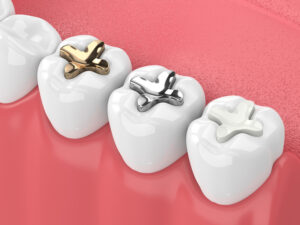Composite vs Metal Fillings: Which Are Best for Taking Care of Your Cavity?
If you have a cavity, you will have two major options for fillings. Given the concerns about mercury in metal fillings, you might think that the choice would be apparent, however metal fillings do have certain advantages over composite fillings in specific instances. Your dentist can assist you in making the best option for your unique situation, but you can start by reviewing some key information regarding metal and composite fillings right here.
What are metal fillings?
Metal fillings are created from a mixture of around 50 percent mercury and other metals like as silver, tin, copper, or zinc, and are sometimes referred to as silver amalgam fillings. Metal fillings have a silver tint and a reflective aspect that makes them stand out. They can, however, be used on the back teeth without compromising the appearance of your smile.
Metal fillings can be used to fill bigger cavities than white composite fillings, however to achieve a solid connection with the metal filling, the dentist must remove additional tooth structure. Metal fillings are extremely long-lasting and are frequently utilized on the biting surfaces of molars.
Although metal fillings do generate a tiny amount of mercury vapor, this level is far smaller than what you’d find in the natural environment, and the EPA considers undamaged metal fillings to be safe. Metal fillings, on the other hand, may pose problems for people who are allergic to metals.
Metal fillings are the most cost-effective way to treat a cavity. Metal fillings have a good track record of surviving for decades if properly cared for, due to their strength and the way the liquid mercury combines with the tooth.
Fillings made of composite materials
Composite fillings are made up of glass or silica, resin, and a light-activated chemical that helps the material set rapidly once it’s been inserted in the tooth. Composite fillings, which may be colored to match the color of your natural tooth enamel, are the most cosmetically acceptable form of filling. They are nearly unnoticeable when fitted by a skilled dentist.
Composite fillings can be used to treat a variety of cavities, albeit they are not indicated for cavities that are extremely big. This form of filling can also be used to repair fractured teeth since the composite material can adhere to a flat surface. Composite fillings are metal-free, which is great news for anyone who have metal allergies or are concerned about dental mercury.
Composite fillings are more complex and time-consuming for a dentist to put than metal fillings, and they tend to cost more.
New and superior composite fillings are always being produced, and these advancements have made the material more robust and long-lasting, even on molars, over time. However, one possible risk is that composite fillings shrink somewhat as they cure, leaving small gaps around the filling’s border. Cold, heat, and germs may be able to enter the tooth through this opening. This raises the danger of sensitivity as well as the probability of the filling failing prematurely.





